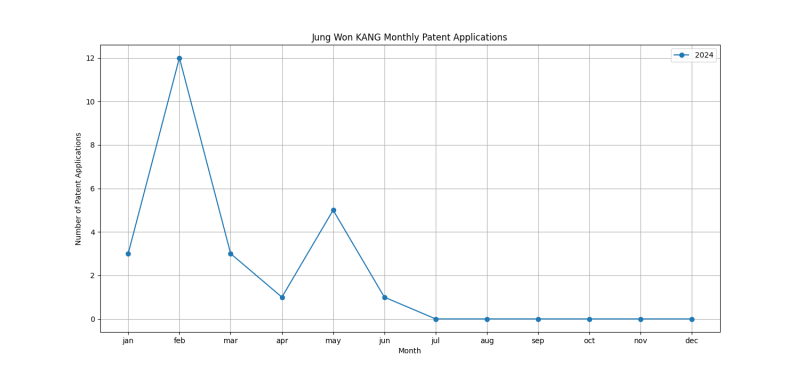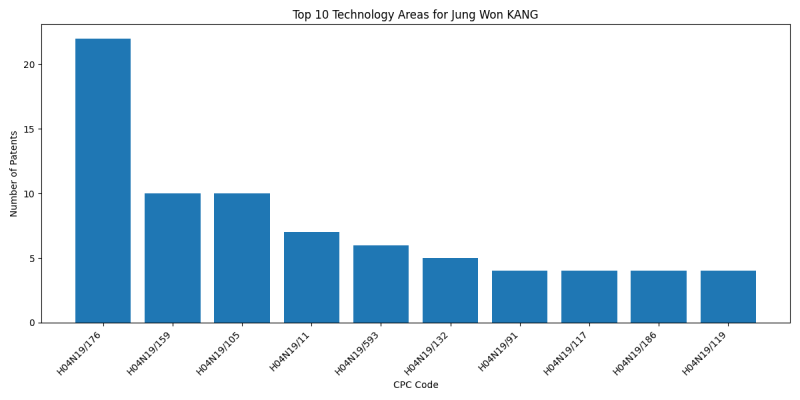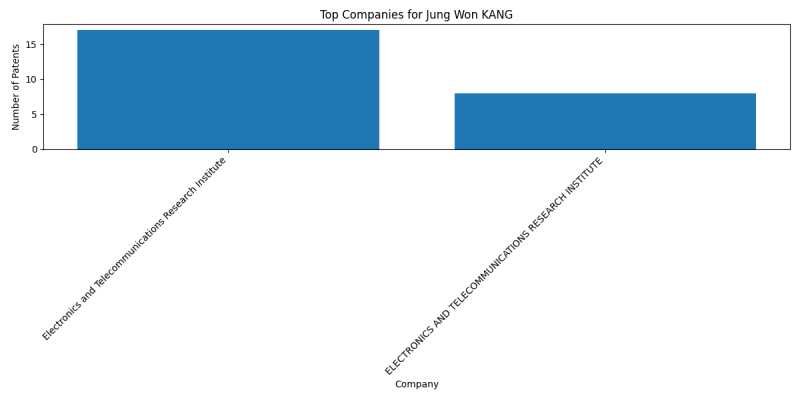Category:Jung Won KANG
Jung Won KANG
Executive Summary
Jung Won KANG is an inventor who has filed 25 patents. Their primary areas of innovation include the unit being an image region, e.g. an object (18 patents), Selection of the reference unit for prediction within a chosen coding or prediction mode, e.g. adaptive choice of position and number of pixels used for prediction (14 patents), by monitoring actual compressed data size at the memory before deciding storage at the transmission buffer (11 patents), and they have worked with companies such as Electronics and Telecommunications Research Institute (21 patents), ELECTRONICS AND TELECOMMUNICATIONS RESEARCH INSTITUTE (4 patents). Their most frequent collaborators include (21 collaborations), (20 collaborations), (19 collaborations).
Patent Filing Activity
Technology Areas
List of Technology Areas
- H04N19/176 (the unit being an image region, e.g. an object): 18 patents
- H04N19/105 (Selection of the reference unit for prediction within a chosen coding or prediction mode, e.g. adaptive choice of position and number of pixels used for prediction): 14 patents
- H04N19/159 (by monitoring actual compressed data size at the memory before deciding storage at the transmission buffer): 11 patents
- H04N19/119 (Adaptive subdivision aspects, e.g. subdivision of a picture into rectangular or non-rectangular coding blocks): 7 patents
- H04N19/70 (characterised by syntax aspects related to video coding, e.g. related to compression standards): 6 patents
- H04N19/593 (involving spatial prediction techniques): 5 patents
- H04N19/186 (PICTORIAL COMMUNICATION, e.g. TELEVISION): 5 patents
- H04N19/11 (among a plurality of spatial predictive coding modes): 5 patents
- H04N19/132 (Sampling, masking or truncation of coding units, e.g. adaptive resampling, frame skipping, frame interpolation or high-frequency transform coefficient masking): 4 patents
- H04N19/96 (Tree coding, e.g. quad-tree coding): 4 patents
- H04N19/13 (Adaptive entropy coding, e.g. adaptive variable length coding [AVLC] or context adaptive binary arithmetic coding [CABAC]): 4 patents
- H04N19/117 (Filters, e.g. for pre-processing or post-processing (sub-band filter banks): 3 patents
- H04N19/137 (Motion inside a coding unit, e.g. average field, frame or block difference): 3 patents
- H04N19/91 (Entropy coding, e.g. variable length coding [VLC] or arithmetic coding): 3 patents
- H04N19/172 (the unit being an image region, e.g. an object): 2 patents
- H04N19/46 (Embedding additional information in the video signal during the compression process (): 2 patents
- H04N19/51 (Motion estimation or motion compensation): 2 patents
- H04N19/513 (Processing of motion vectors): 2 patents
- H04N19/146 (Data rate or code amount at the encoder output): 2 patents
- H04N19/44 (Decoders specially adapted therefor, e.g. video decoders which are asymmetric with respect to the encoder): 2 patents
- H04N19/188 (PICTORIAL COMMUNICATION, e.g. TELEVISION): 1 patents
- H04N19/82 (involving filtering within a prediction loop): 1 patents
- H04N19/103 (using adaptive coding): 1 patents
- H04N19/107 (between spatial and temporal predictive coding, e.g. picture refresh): 1 patents
- H04N19/139 (Analysis of motion vectors, e.g. their magnitude, direction, variance or reliability): 1 patents
- H04N19/167 (Position within a video image, e.g. region of interest [ROI]): 1 patents
- H04N19/184 (PICTORIAL COMMUNICATION, e.g. TELEVISION): 1 patents
- H04N19/147 (according to rate distortion criteria (rate-distortion as a criterion for motion estimation): 1 patents
- H04N19/129 (Scanning of coding units, e.g. zig-zag scan of transform coefficients or flexible macroblock ordering [FMO]): 1 patents
- H04N19/18 (PICTORIAL COMMUNICATION, e.g. TELEVISION): 1 patents
- H04N19/169 (characterised by the coding unit, i.e. the structural portion or semantic portion of the video signal being the object or the subject of the adaptive coding): 1 patents
- G06V10/7715 (IMAGE OR VIDEO RECOGNITION OR UNDERSTANDING): 1 patents
- G06V10/82 (IMAGE OR VIDEO RECOGNITION OR UNDERSTANDING): 1 patents
- H04N19/124 (Quantisation): 1 patents
- H04N19/189 (characterised by the adaptation method, adaptation tool or adaptation type used for the adaptive coding): 1 patents
- H04N19/30 (using hierarchical techniques, e.g. scalability (): 1 patents
- H04N19/149 (by estimating the code amount by means of a model, e.g. mathematical model or statistical model): 1 patents
- H04N19/182 (PICTORIAL COMMUNICATION, e.g. TELEVISION): 1 patents
- H04N19/174 (the region being a slice, e.g. a line of blocks or a group of blocks): 1 patents
- G06T3/067 (Reshaping or unfolding 3D tree structures onto 2D planes): 1 patents
- G06T3/4046 (using neural networks): 1 patents
- H04N19/187 (PICTORIAL COMMUNICATION, e.g. TELEVISION): 1 patents
- H04N19/31 (in the temporal domain): 1 patents
- H04N19/33 (in the spatial domain): 1 patents
- H04N19/463 (Embedding additional information in the video signal during the compression process (): 1 patents
- H04N19/52 (PICTORIAL COMMUNICATION, e.g. TELEVISION): 1 patents
- G06T9/002 ({using neural networks}): 1 patents
- G06T9/001 ({Model-based coding, e.g. wire frame}): 1 patents
- H04N19/126 (Details of normalisation or weighting functions, e.g. normalisation matrices or variable uniform quantisers): 1 patents
- H04N19/50 (using predictive coding (): 1 patents
- H04N19/12 (Selection from among a plurality of transforms or standards, e.g. selection between discrete cosine transform [DCT] and sub-band transform or selection between H.263 and H.264): 1 patents
- H04N19/619 ({the transform being operated outside the prediction loop}): 1 patents
- G10L19/038 (SPEECH ANALYSIS TECHNIQUES OR SPEECH SYNTHESIS; SPEECH RECOGNITION; SPEECH OR VOICE PROCESSING TECHNIQUES; SPEECH OR AUDIO CODING OR DECODING): 1 patents
- G10L21/0208 (SPEECH ANALYSIS TECHNIQUES OR SPEECH SYNTHESIS; SPEECH RECOGNITION; SPEECH OR VOICE PROCESSING TECHNIQUES; SPEECH OR AUDIO CODING OR DECODING): 1 patents
- G10L25/30 (SPEECH ANALYSIS TECHNIQUES OR SPEECH SYNTHESIS; SPEECH RECOGNITION; SPEECH OR VOICE PROCESSING TECHNIQUES; SPEECH OR AUDIO CODING OR DECODING): 1 patents
- G10L19/16 (SPEECH ANALYSIS TECHNIQUES OR SPEECH SYNTHESIS; SPEECH RECOGNITION; SPEECH OR VOICE PROCESSING TECHNIQUES; SPEECH OR AUDIO CODING OR DECODING): 1 patents
Companies
List of Companies
- Electronics and Telecommunications Research Institute: 21 patents
- ELECTRONICS AND TELECOMMUNICATIONS RESEARCH INSTITUTE: 4 patents
Collaborators
- Jin Ho LEE (21 collaborations)
- Ha Hyun LEE (20 collaborations)
- Sung Chang LIM (19 collaborations)
- Hui Yong KIM (17 collaborations)
- Jin Soo CHOI (9 collaborations)
- Hyun Suk KO (6 collaborations)
- Dong San JUN (6 collaborations)
- Seung Hyun CHO (5 collaborations)
- Soo Woong KIM (3 collaborations)
- Gun BANG (3 collaborations)
- Gwang Hoon PARK (3 collaborations)
- Tae Hyun KIM (3 collaborations)
- Dae Young LEE (3 collaborations)
- Dae Yeon KIM (2 collaborations)
- JooYoung LEE (2 collaborations)
- Youn Hee KIM (2 collaborations)
- Se Yoon JEONG (2 collaborations)
- Yung Lyul LEE (2 collaborations)
- Inseon JANG (2 collaborations)
- Woo-taek LIM (2 collaborations)
- Soo Young PARK (2 collaborations)
- Seung Kwon BEACK (2 collaborations)
- Jongmo SUNG (2 collaborations)
- Byeongho CHO (2 collaborations)
- Tae Jin LEE (2 collaborations)
- Minje KIM of Bloomington IN (US) (2 collaborations)
- Haici YANG of Bloomington IN (US) (2 collaborations)
- Ju Ock LEE (1 collaborations)
- Woo Woen GWUN (1 collaborations)
- Won Jun LEE (1 collaborations)
- Young Su HEO (1 collaborations)
- Hye Won JEONG (1 collaborations)
- Seung Hwan JANG (1 collaborations)
- Yeong Woong KIM (1 collaborations)
- Jang Hyun YU (1 collaborations)
- Jun Woo CHOI (1 collaborations)
- Jin Woong KIM (1 collaborations)
- Ji Yeon JUNG (1 collaborations)
- Nam Uk KIM (1 collaborations)
- Myung Jun KIM (1 collaborations)
- Yang Woo KIM (1 collaborations)
- Jae Gon KIM (1 collaborations)
- Do Hyeon PARK (1 collaborations)
- Ji Hoon DO (1 collaborations)
- Seong Jun BAE (1 collaborations)
- Byeung Woo JEON (1 collaborations)
- Jee Yoon PARK (1 collaborations)
Subcategories
This category has the following 12 subcategories, out of 12 total.
D
G
H
J
S
T
- Jin Ho LEE
- Ha Hyun LEE
- Sung Chang LIM
- Hui Yong KIM
- Jin Soo CHOI
- Hyun Suk KO
- Dong San JUN
- Seung Hyun CHO
- Soo Woong KIM
- Gun BANG
- Gwang Hoon PARK
- Tae Hyun KIM
- Dae Young LEE
- Dae Yeon KIM
- JooYoung LEE
- Youn Hee KIM
- Se Yoon JEONG
- Yung Lyul LEE
- Inseon JANG
- Woo-taek LIM
- Soo Young PARK
- Seung Kwon BEACK
- Jongmo SUNG
- Byeongho CHO
- Tae Jin LEE
- Minje KIM of Bloomington IN (US)
- Haici YANG of Bloomington IN (US)
- Ju Ock LEE
- Woo Woen GWUN
- Won Jun LEE
- Young Su HEO
- Hye Won JEONG
- Seung Hwan JANG
- Yeong Woong KIM
- Jang Hyun YU
- Jun Woo CHOI
- Jin Woong KIM
- Ji Yeon JUNG
- Nam Uk KIM
- Myung Jun KIM
- Yang Woo KIM
- Jae Gon KIM
- Do Hyeon PARK
- Ji Hoon DO
- Seong Jun BAE
- Byeung Woo JEON
- Jee Yoon PARK
- Jung Won KANG
- Inventors
- Inventors filing patents with Electronics and Telecommunications Research Institute
- Inventors filing patents with ELECTRONICS AND TELECOMMUNICATIONS RESEARCH INSTITUTE


